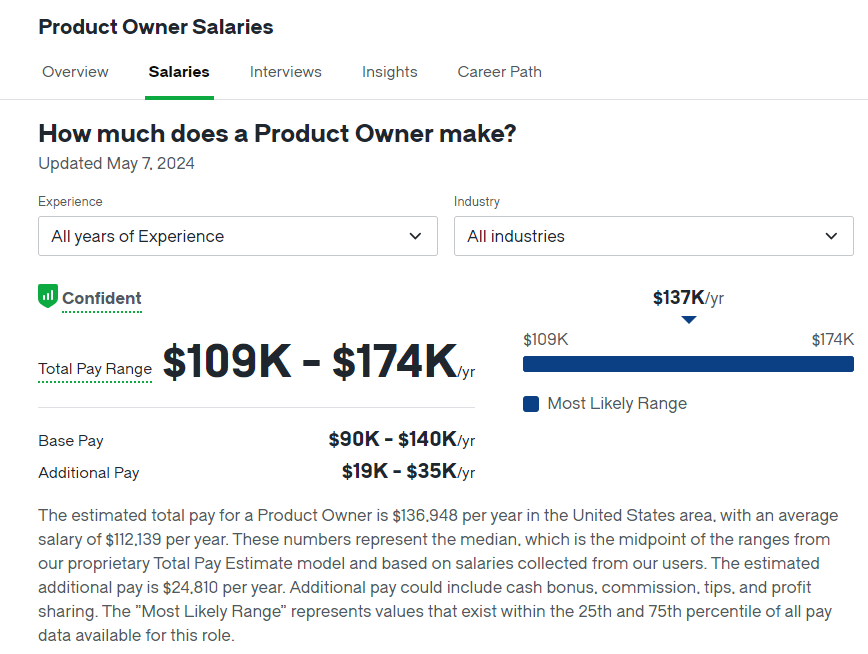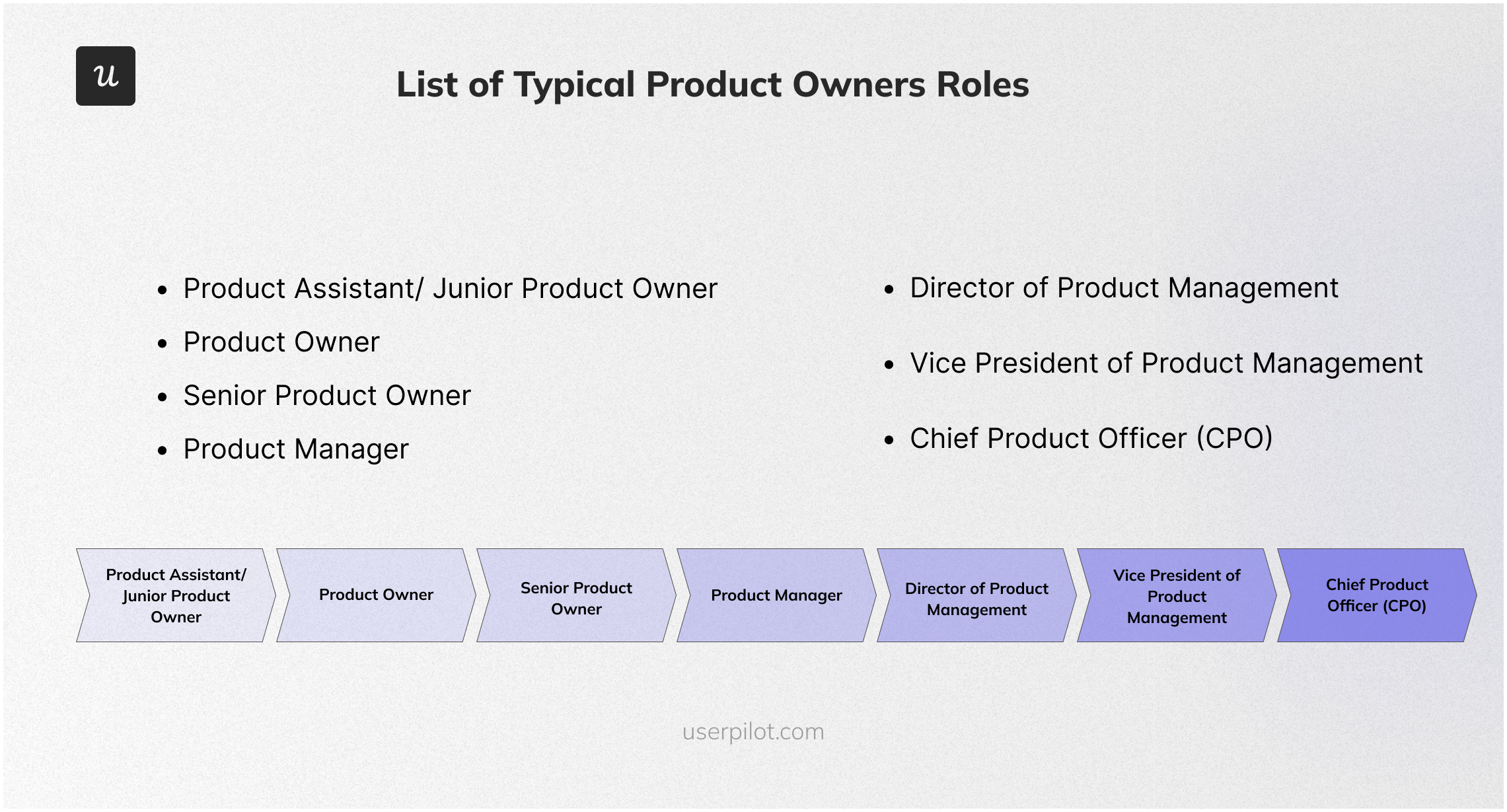![Product Owner Salary [+ Resources to Advance]](https://blog-static.userpilot.com/blog/wp-content/uploads/2024/06/Product-Owner-SalaryResources-to-Advance.png)
Try Userpilot Now
See Why 1,000+ Teams Choose Userpilot

What is a product owner?
In SaaS companies, a product owner is responsible for developing the product’s vision and navigating the product roadmap to maximize value. This means defining goals to be achieved so that everyone, from the development team to the customers, is on the same page about the product’s future. The product owner is also often referred to as the voice of the customer (VOC) on the Scrum team.
The role also calls for tactical expertise. The product owner not only has to communicate the tasks to be done but also organize sprints and coordinate teamwork until the final product is delivered.
Product owner’s main responsibilities
There are multiple facets of product development that the product owner needs to constantly keep an eye on. These vary from customer understanding to release management to tracking product performance, all the while collaborating across teams as well.
Here are all the main responsibilities that every product owner has to fulfill:
- Define a clear product vision and strategy, aligned with the overall goals of the organization.
- Maintain the product backlog so it is up-to-date and contains detailed user stories and well-documented acceptance criteria.
- Regularly plan and coordinate sprints, closely collaborating with customers and the development team to prioritize requirements based on customer needs and resources utilized.
- Work with cross-functional teams, including customer support, design, and marketing, to ensure everyone is on the same page for a smooth release.
- Gather and analyze customer feedback, track product usage, and perform relevant analysis, like funnel or path analysis, for examining problem areas to inform product decisions.
- Oversee the release process to ensure quality guidelines are met and to optimally schedule new features or updates.
- Monitor product performance by regularly tracking metrics such as user engagement, retention and conversion rates, and customer satisfaction to measure product success.
How much does a product owner make?
According to Glassdoor, the average product owner salary across the United States is $137,000. However, this salary varies greatly depending on, first and foremost, your level of experience.
Here’s a look at what you can expect to earn depending on how much experience you have:
- Early-level product owner (1 to 3 years): $108,000/year
- Mid-level product owner (4 to 6 years): $119,000/year
- Senior product owner (8+ years): $132,000/year
- Experienced product owner (15+ years): $157,000/year
All these numbers are averages, and depending on the company, you can earn additional bonuses and performance-based rewards on top of this base salary.
After experience, another important factor that has a big impact on salary is the location. Since more companies, especially SaaS companies, are employing a geographically dispersed workforce, it is now common for companies to offer a location-based salary.
Here are the average product owner salaries in the following big cities of the US, according to Glassdoor:
- San Francisco: $140,073/year
- New York: $126,380/year
- Washington, DC: $123,885/year
- Boston: $121,013/year
- Chicago: $114,800/year
Apart from experience and location, there are certain industries where demand for product owners is growing. As a result, roles in these industries pay better as well. Some of these sectors and their average salaries include:
- Healthcare: $153,000/year
- Personal consumer services: $150,000/year
- Education: $145,000/year
- Finance: $140,000/year
Product owner career path
- Product Assistant / Junior Product Owner: This is an entry-level position, where you need to prove your expertise and develop your understanding of the product to advance.
- Product Owner: Typically, after 2 years at the entry-level position, once you develop your Agile methodology skillset, you can become a product owner.
- Senior Product Owner: For this role, you need at least 5 years of experience and advanced knowledge of product roadmap techniques like Kano or Pareto. A CSPO or equivalent certification is a strong plus.
- Product Manager: To reach this role, you need over 6 to 8 years of product ownership, project management, and product design experience. You should also have extensive experience working with engineering, development, and user research teams.
- Director of Product Management: Requires 10-plus years of product manager experience strategically running a successful product and continuously learning through certifications like Certified Product Manager (CPM) or Advanced Product Management Certification (APMC). Familiarity with the E-Verify program is also a necessity (as required by law in certain locations).
- Vice President of Product Management: To become the VP, you need over 15 years of experience handling a portfolio of products, effectively collaborating with C-Suite, PMs, engineering, design, and data while learning relevant guidelines for operations, compliance, and legal as well.
- Chief Product Officer (CPO): Responsible for all products and their entire lifecycles, a CPO position typically requires 15 to 20 years of relevant experience in similar companies. At least 8 to 10 of those years should be in leadership or managerial roles, along with a Master’s degree as well, more often than not.
Best practices to be a great product owner
- Define clear objectives: For the development, customer success, marketing, and design teams to do a good job improving the product, the product owner first needs to clearly outline the requirements.
- Build stakeholder trust: Stakeholders can include upper management, the development team, or customers. To ensure project success, all these parties need to work well together, which can only happen if a level of trust exists.
- Always focus on customer feedback: In order to truly ensure product success, you should continuously gather and analyze user feedback to uncover opportunities and friction points.
- Regularly refine product backlog: Managing the backlog should be done often to provide the development team with implementable next steps and ensure continuous delivery of customer value.
- Be present: Apart from the tactical side of the role, a product owner should also actively participate as a team member, being present when others need guidance and helping out where needed.
Best resources for product owners
Becoming a product owner means exploring several diverse fields, from leadership and teamwork to the technical side of things, like Agile and Scrum projects. Here are some resources to help you along in your journey.
Best books for product owners
- “Scrum: The Art of Doing Twice the Work in Half the Time” by Jeff Sutherland: From the co-creator of Scrum, uncover insights into the approach that changed how software companies work in Agile environments.
- “Inspired: How to Create Products Customers Love” by Marty Cagan: Discover tips on how big tech giants like Google and Amazon design their products to continuously deliver great value.
You can find both these books on Amazon, along with their audiobooks as well.
Best webinars for product owners
Here’s a comprehensive list of top webinar sources for product owners, encompassing various needs and focusing on both general product management and software-specific topics:
- Userpilot Events focuses on product growth and user onboarding, key areas for product success. Their webinars can provide valuable insights into optimizing user experience, feature adoption, and engagement strategies.
- Product School offers a mix of free and paid webinars on a wide range of product management topics like product strategy, user research, user story creation, and prioritization.
- Mind the Product frequently hosts webinars on product management best practices, including backlog management, building a product roadmap, and fostering collaboration with development teams.
- Brighttalk: Offers webinars on various topics, including product management. You can find upcoming webinars on product management by searching for the topic on their website.
Best podcasts for product owners
- “Agile for Humans” podcast by Ryan Ripley: Available on Audible and Apple podcasts, this discusses Agile and Scrum practices and different roles necessary to build a successful product.
- “The Product Podcast” by The Product School: Available on Apple podcasts and The Product School site, this features expert interviews with product leaders and experts from Google and Facebook.
Best blogs for product owners
- Product Coalition: The largest community of product management resources, this blog provides everything product-related you can imagine, from building roadmaps and user stories to iterative product improvements and stakeholder management.
- The Scrum.org blog: Find guides about various Scrum roles and how to grow in them, including product owner roles as well.
Best podcasts for product owners
- “Agile for Humans” podcast by Ryan Ripley: Available on Audible and Apple podcasts, this discusses Agile and Scrum practices and different roles necessary to build a successful product.
- “The Product Podcast” by The Product School: Available on Apple podcasts and The Product School site, this features expert interviews with product leaders and experts from Google and Facebook.
Best tools for product owners
If you’re seriously considering growing in your product owner career, there are certain tools that you definitely need to know of. These tools don’t just relate to product management but instead cover a wide variety of skills, from task collaboration to making data analysis easier. Here are the top picks for you:
- The best tool for product management – Confluence: Makes knowledge management easier by providing a single source of truth for all product-related documentation, such as product specifications, meeting notes, and approval guidelines.
- Project management made easy with Jira: A popular bug and issue-tracking tool to help you manage and prioritize product backlogs and plan sprints.
- The answer to all progress tracking problems – Trello: Great for task organization, Trello enables you to assign tasks, track team progress, and easily collaborate with all team members.
- Perfect product design effortlessly with InVision Studio: Easily collaborate with the design team for upcoming product updates or releases, view prototypes, and test out design updates.
- The best tool for product and user experience insights – Userpilot: An all-in-one product platform that comes with both engagement and analytics features that can empower product teams to create engaging, user-centric experiences while leveraging data-driven insights to continually refine and enhance their products.
- The most popular tool for data analysis – Tableau: Product owners need to extract and visualize actionable insights from the customer feedback and usage tracking data they gather, which becomes easier with Tableau.
Conclusion
Now that you have a better understanding of the salary range for a product owner position, you can take steps to improve your earning potential. Consider pursuing relevant certifications, developing your skillset, or negotiating effectively during the job offer stage
Looking into tools for product owners? Userpilot is an all-in-one product platform with engagement features and powerful analytics capabilities. Book a demo to see it in action!








